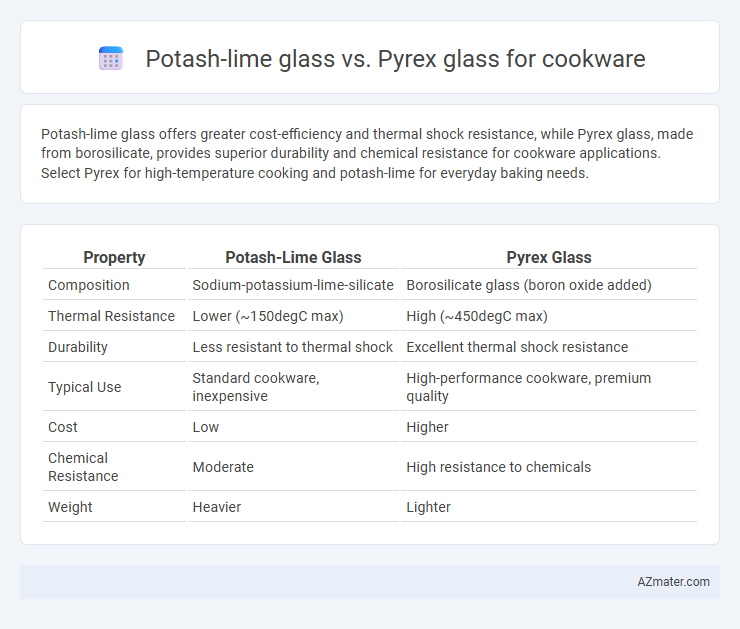Potash-lime glass offers greater cost-efficiency and thermal shock resistance, while Pyrex glass, made from borosilicate, provides superior durability and chemical resistance for cookware applications. Select Pyrex for high-temperature cooking and potash-lime for everyday baking needs.
Table of Comparison
| Property | Potash-Lime Glass | Pyrex Glass |
|---|---|---|
| Composition | Sodium-potassium-lime-silicate | Borosilicate glass (boron oxide added) |
| Thermal Resistance | Lower (~150degC max) | High (~450degC max) |
| Durability | Less resistant to thermal shock | Excellent thermal shock resistance |
| Typical Use | Standard cookware, inexpensive | High-performance cookware, premium quality |
| Cost | Low | Higher |
| Chemical Resistance | Moderate | High resistance to chemicals |
| Weight | Heavier | Lighter |
Introduction to Cookware Glass Types
Potash-lime glass and Pyrex glass differ significantly in composition and thermal durability, with potash-lime glass being a common, affordable material used in everyday cookware, while Pyrex glass consists of borosilicate known for its superior heat resistance and reduced thermal expansion. Cookware made from Pyrex glass withstands rapid temperature changes and high heat, making it ideal for oven use and microwave cooking, whereas potash-lime glass is more prone to cracking under thermal shock. Understanding these distinctions helps consumers select cookware that balances cost, durability, and performance based on cooking needs.
What Is Potash-Lime Glass?
Potash-lime glass is a common type of soda-lime glass that incorporates potassium oxide (potash) to improve chemical durability and thermal stability while maintaining cost-effectiveness, making it suitable for everyday cookware. Compared to Pyrex glass, which is typically borosilicate glass known for its superior thermal shock resistance, potash-lime glass is less resistant to rapid temperature changes but still offers adequate heat tolerance for regular cooking tasks. Its widespread use in kitchenware is due to its balance of strength, clarity, and affordability.
Understanding Pyrex Glass Composition
Pyrex glass for cookware is primarily made from borosilicate glass, which contains about 80% silica and 12-13% boron oxide, providing superior thermal shock resistance compared to potash-lime glass. Potash-lime glass, used in some cheaper cookware, has a higher coefficient of thermal expansion, making it more prone to cracking under rapid temperature changes. Understanding Pyrex's borosilicate composition highlights its durability and suitability for high-temperature cooking applications.
Thermal Shock Resistance Comparison
Potash-lime glass demonstrates lower thermal shock resistance compared to Pyrex glass, making it more prone to cracking under sudden temperature changes. Pyrex glass, specifically formulated with borosilicate, offers superior durability by withstanding rapid heating and cooling cycles up to 450degC without structural damage. This enhanced thermal stability ensures Pyrex cookware maintains integrity and safety in high-heat cooking environments where potash-lime glass would typically fail.
Durability and Breakage: Potash-Lime vs Pyrex
Potash-lime glass, commonly used in ordinary cookware, is less durable and more prone to breakage under thermal stress compared to Pyrex glass, which is made from borosilicate. Pyrex borosilicate glass offers superior thermal shock resistance, making it more durable and less likely to crack or shatter during rapid temperature changes. The enhanced breakage resistance of Pyrex glass ensures longer lifespan and reliability for cookware subjected to high heat and cooling cycles.
Heat Distribution and Cooking Performance
Potash-lime glass offers moderate heat distribution with a tendency to develop hot spots, which can affect the cooking consistency, while Pyrex glass, made from borosilicate, provides superior thermal resistance and evenly distributes heat for more precise cooking. The low thermal expansion of Pyrex minimizes the risk of cracking under rapid temperature changes, enhancing durability and performance during high-heat cooking. Potash-lime glass cookware is generally less expensive but may not perform as well as Pyrex when it comes to maintaining uniform cooking temperatures and long-term reliability.
Chemical Resistance and Food Safety
Potash-lime glass, commonly used in everyday cookware, exhibits moderate chemical resistance but can be susceptible to alkaline degradation and may release trace elements over time. Pyrex glass, formulated from borosilicate, offers superior chemical resistance, reducing the risk of leaching harmful substances and ensuring higher food safety standards. Its thermal stability also helps prevent contamination, making Pyrex a preferred choice for safe, durable cookware.
Cost and Availability for Home Cooks
Potash-lime glass cookware is generally more affordable and widely available for home cooks, making it a budget-friendly option found in many retail stores. Pyrex glass, made from borosilicate, usually comes at a higher price point due to its enhanced thermal shock resistance and durability, but it may be less common in some regions. Home cooks often choose potash-lime glass for everyday use because of its accessibility, while Pyrex is preferred for tasks requiring higher temperature tolerance despite its limited availability.
Maintenance and Cleaning Considerations
Potash-lime glass cookware requires careful handling to avoid scratches and thermal shock, as it is more prone to damage during cleaning with abrasive materials compared to Pyrex glass. Pyrex glass is made from borosilicate, offering superior resistance to thermal expansion and chemical corrosion, allowing easier maintenance with everyday detergents and less risk of cracking. Both types benefit from non-abrasive sponges and gradual temperature changes to extend their lifespan and maintain clarity.
Which Glass Type Is Best for Your Kitchen?
Potash-lime glass offers excellent clarity and thermal resistance for everyday cookware, making it ideal for baking and serving dishes that require gentle heat changes. Pyrex glass, made from borosilicate, excels in thermal shock resistance, allowing cookware to transition from freezer to oven without cracking, perfect for high-temperature cooking and durability. Choosing Pyrex is best for kitchens demanding versatile, heat-resistant cookware, while potash-lime suits those prioritizing affordability and frequent, moderate-heat use.

Infographic: Potash-lime glass vs Pyrex glass for Cookware
 azmater.com
azmater.com